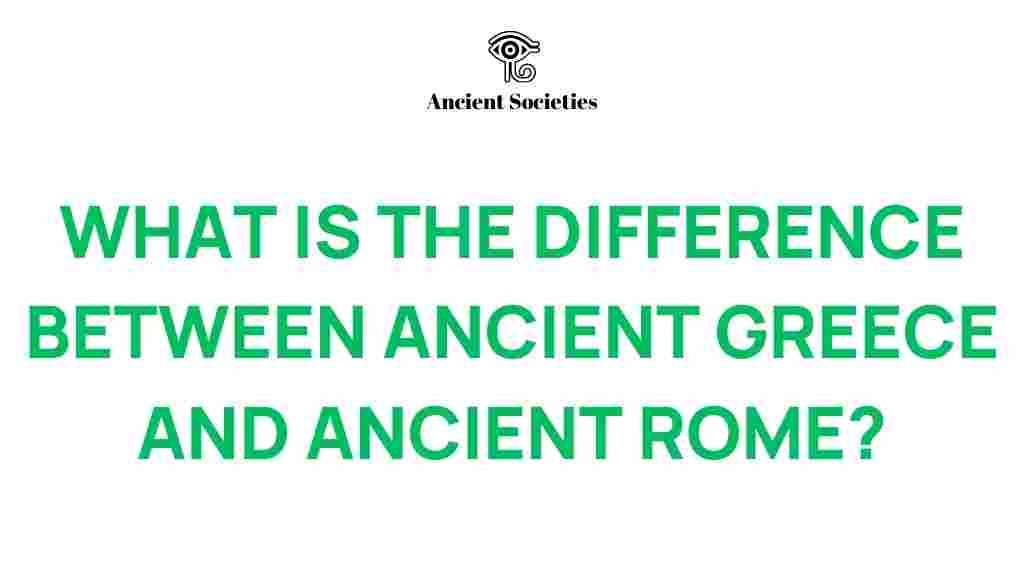Unraveling the Distinct Identities of Ancient Greece and Rome
The civilizations of Ancient Greece and Ancient Rome are two of the most influential cultures in Western history. Their legacies in philosophy, governance, architecture, and art continue to shape modern society. By exploring their unique identities, we can better understand how these two empires contributed to the tapestry of human civilization.
Understanding the Historical Context
The historical timelines of Ancient Greece and Ancient Rome provide a foundation for understanding their distinct identities. While both cultures flourished in the Mediterranean region, their developments occurred in different eras and under different circumstances.
- Ancient Greece: Generally recognized as the birthplace of democracy, philosophy, and theater, Ancient Greece thrived from around 800 BC to 146 BC.
- Ancient Rome: Emerging around 753 BC, Ancient Rome transitioned from a monarchy to a republic, and eventually to an empire, lasting until the West fell in 476 AD.
Key Differences in Culture and Society
The cultural and societal structures of Ancient Greece and Ancient Rome highlight their unique identities.
1. Social Structure
In Ancient Greece, city-states (or poleis) like Athens and Sparta had distinct social hierarchies. Athens was known for its democratic governance, where citizens participated directly in decision-making. In contrast, Sparta emphasized military prowess and discipline.
Ancient Rome had a more unified approach with its class system, which included patricians (aristocrats), plebeians (commoners), and slaves. Roman society was heavily influenced by legal and political systems that were more centralized compared to the fragmented city-states of Greece.
2. Philosophy and Intellectual Life
Ancient Greece is renowned for its philosophers such as Socrates, Plato, and Aristotle, who laid the groundwork for Western philosophy. Their exploration of ethics, politics, and metaphysics has had a long-lasting impact on intellectual thought.
Conversely, Ancient Rome was more practical in its philosophical pursuits, focusing on Stoicism and Epicureanism. Roman philosophers like Seneca and Cicero emphasized ethics and moral duty, often intertwining their thoughts with political life.
3. Religion and Mythology
The religious practices in Ancient Greece revolved around a pantheon of gods, with each city-state often having its own patron deity. The myths surrounding these gods influenced their art, literature, and rituals.
Ancient Rome adopted many Greek deities but integrated them into their own culture, often associating them with Roman virtues and the state’s power. As Rome expanded, it incorporated the gods of conquered peoples, leading to a more syncretic religious practice.
Architecture: A Reflection of Identity
The architectural achievements of both empires are profound, showcasing their values and technological prowess.
1. Ancient Greece
Greek architecture is characterized by its use of columns and symmetry. The three classical orders—Doric, Ionic, and Corinthian—are hallmarks of Greek design. Key examples include:
- The Parthenon: A temple dedicated to Athena, symbolizing the power of Athens.
- The Theatre of Epidaurus: Renowned for its acoustics and symmetry.
2. Ancient Rome
Roman architecture, on the other hand, is known for its grandeur and engineering innovations, including the use of arches, vaults, and concrete. Notable structures include:
- The Colosseum: An iconic symbol of Roman engineering and entertainment.
- The Pantheon: A temple that exemplifies the mastery of dome construction.
The Concept of Democracy and Governance
One of the most significant contributions of Ancient Greece is the concept of democracy. The city-state of Athens developed a direct democracy where citizens could participate in legislative decisions. This model of governance inspired future democratic systems.
In contrast, Ancient Rome established a republican form of government that influenced modern representative democracies. The Roman Senate played a crucial role in governance, balancing power among various branches of government. Their legal system, including the Twelve Tables, laid the groundwork for modern legal principles.
Step-by-Step Comparison: Ancient Greece vs. Ancient Rome
To better understand the distinct identities of these two civilizations, consider the following comparison:
- Governance: Greece – Direct democracy; Rome – Republic with Senate.
- Philosophy: Greece – Focus on abstract thought; Rome – Practical ethics.
- Architecture: Greece – Columns and temples; Rome – Arches and monumental structures.
- Religion: Greece – Polytheistic with localized worship; Rome – Syncretic, integrating many cultures.
Troubleshooting Misconceptions
Understanding the nuances between Ancient Greece and Ancient Rome can be challenging. Here are some common misconceptions and clarifications:
- Myth: Greece and Rome were the same culture.
- Fact: While they influenced each other, they had distinct societal structures, philosophies, and artistic expressions.
- Myth: Democracy was the same in both societies.
- Fact: Greek democracy was direct, while Roman governance was representative.
- Myth: All Greeks worshipped the same gods.
- Fact: Different city-states had varying deities and practices.
Conclusion: The Lasting Impact of Ancient Civilizations
Both Ancient Greece and Ancient Rome have left indelible marks on the world, shaping concepts of governance, philosophy, and art that persist today. Their unique identities, while intertwined, reflect the diversity of human thought and achievement. Understanding these distinct civilizations helps us appreciate the complex tapestry of our shared history.
As we continue to explore these ancient societies, we can draw parallels to modern issues, such as the evolution of democracy and the role of philosophy in addressing ethical dilemmas. For further insights into the relationship between these two great civilizations, you can visit this resource.
To delve deeper into the architectural marvels of these empires, check out this article that highlights their contributions to modern architecture.
This article is in the category History and created by AncientSocieties Team
